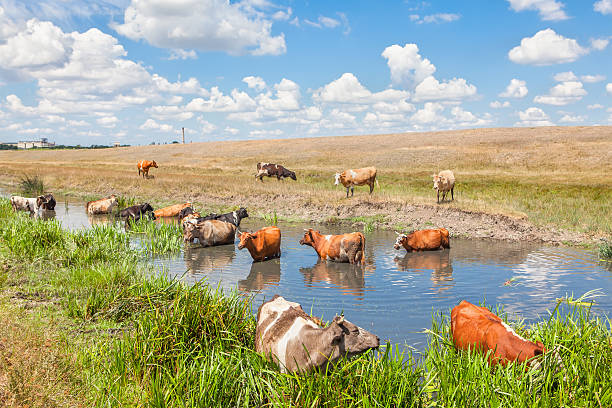Heat stress in cattle becomes a real concern during hot summer months, especially when temperatures rise, humidity increases, and wind speeds drop. Unlike humans, who sweat to cool down, cattle can’t regulate their body temperature the same way—making them more vulnerable to heat-related health issues.
According to Dr. AJ Tarpoff, beef extension veterinarian at Kansas State University, recognizing and responding to signs of heat stress is critical to maintaining both animal wellbeing and productivity.
“Cattle don’t sweat like we do,” said Tarpoff. “Instead, they cope with heat by panting and changing their behavior—like standing more, crowding around water tanks, or bunching up in the shade.”
While these behaviors are attempts to cool off, they can sometimes backfire. For instance, cattle that huddle together for shade may actually block airflow, worsening the heat stress.
🔥 Key Conditions Behind Heat Stress
Four main weather factors contribute to heat stress in cattle:
-
High temperatures
-
High humidity
-
Low wind speeds
-
Strong sunlight
Tarpoff advises producers to track these factors using the Animal Comfort Index, available through the K-State Mesonet. This tool helps estimate how cattle are experiencing their environment—even if it feels comfortable to humans.
“Cattle may be suffering even when we think the weather is fine. Monitoring their comfort index helps producers take timely action,” he said.
💧 Back to Basics: Water, Feed, and Timing
When it comes to heat relief, Tarpoff encourages producers to keep things simple:
-
Water is essential: Cattle’s water needs can double when temperatures rise from 70°F to 90°F. Ensure clean, cool water is always accessible with adequate flow and space for animals to drink.
-
Adjust feeding times: Consider feeding cattle later in the evening. Digestion produces internal heat, and shifting it to cooler nighttime hours reduces added stress.
“Feeding during the cooler part of the day helps manage the heat of fermentation inside the animal’s body,” said Tarpoff.
🌳 Shade Structures Show Results
Providing shade is one of the most effective ways to reduce heat stress. A recent two-year K-State study confirmed that cattle housed under shade not only experienced lower panting rates, but also:
-
Ate more efficiently
-
Grew faster
-
Drank over a gallon less water per day, on average
“Shades are more than just comfort—they’re an investment in better performance,” said Tarpoff.
🐄 Other Heat-Relief Strategies
Additional tools to help cattle beat the heat include:
-
Straw bedding to lower ground temperatures
-
Fence-line sprinklers to cool down pens
-
Ensuring adequate ventilation and air movement, especially in dry lots
🧊 Cool Cattle, Better Results
Managing heat stress is just as important as feeding and watering, says Tarpoff.
“If cattle are comfortable, they’ll eat better, grow better, and stay healthier. It’s about creating the right environment for them to thrive.”
As summer temperatures soar, simple changes can make a big difference—and producers who plan ahead will see the benefits in animal health and performance.
Simple Solutions Help Keep Cattle Cool in Hot Weather
Heat stress in cattle becomes a real concern during hot summer months, especially when temperatures rise, humidity increases, and wind speeds drop. Unlike humans, who sweat to cool down, cattle can’t regulate their body temperature the same way—making them more vulnerable to heat-related health issues.
According to Dr. AJ Tarpoff, beef extension veterinarian at Kansas State University, recognizing and responding to signs of heat stress is critical to maintaining both animal wellbeing and productivity.
“Cattle don’t sweat like we do,” said Tarpoff. “Instead, they cope with heat by panting and changing their behavior—like standing more, crowding around water tanks, or bunching up in the shade.”
While these behaviors are attempts to cool off, they can sometimes backfire. For instance, cattle that huddle together for shade may actually block airflow, worsening the heat stress.
🔥 Key Conditions Behind Heat Stress
Four main weather factors contribute to heat stress in cattle:
-
High temperatures
-
High humidity
-
Low wind speeds
-
Strong sunlight
Tarpoff advises producers to track these factors using the Animal Comfort Index, available through the K-State Mesonet. This tool helps estimate how cattle are experiencing their environment—even if it feels comfortable to humans.
“Cattle may be suffering even when we think the weather is fine. Monitoring their comfort index helps producers take timely action,” he said.
💧 Back to Basics: Water, Feed, and Timing
When it comes to heat relief, Tarpoff encourages producers to keep things simple:
-
Water is essential: Cattle’s water needs can double when temperatures rise from 70°F to 90°F. Ensure clean, cool water is always accessible with adequate flow and space for animals to drink.
-
Adjust feeding times: Consider feeding cattle later in the evening. Digestion produces internal heat, and shifting it to cooler nighttime hours reduces added stress.
“Feeding during the cooler part of the day helps manage the heat of fermentation inside the animal’s body,” said Tarpoff.
🌳 Shade Structures Show Results
Providing shade is one of the most effective ways to reduce heat stress. A recent two-year K-State study confirmed that cattle housed under shade not only experienced lower panting rates, but also:
-
Ate more efficiently
-
Grew faster
-
Drank over a gallon less water per day, on average
“Shades are more than just comfort—they’re an investment in better performance,” said Tarpoff.
🐄 Other Heat-Relief Strategies
Additional tools to help cattle beat the heat include:
-
Straw bedding to lower ground temperatures
-
Fence-line sprinklers to cool down pens
-
Ensuring adequate ventilation and air movement, especially in dry lots
🧊 Cool Cattle, Better Results
Managing heat stress is just as important as feeding and watering, says Tarpoff.
“If cattle are comfortable, they’ll eat better, grow better, and stay healthier. It’s about creating the right environment for them to thrive.”
As summer temperatures soar, simple changes can make a big difference—and producers who plan ahead will see the benefits in animal health and performance.



